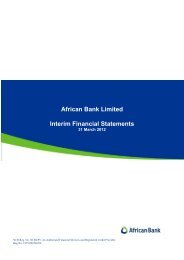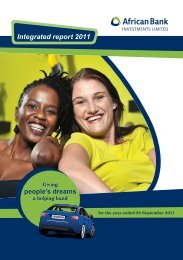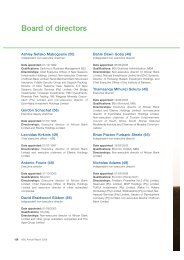Download - African Bank
Download - African Bank
Download - African Bank
Create successful ePaper yourself
Turn your PDF publications into a flip-book with our unique Google optimized e-Paper software.
Risk review continued<br />
The risks below are rank ordered in terms of their inherent risks, ie the effectiveness of current controls have not been taken into consideration.<br />
Top ten risks Mitigating factors<br />
Risk 1: Liquidity and interest rate risk<br />
Due to the gearing of banks, a loss of confidence could A natural interest rate hedge is maintained. The lending book consists<br />
result in a withdrawal of deposits to the extent that the mainly of fixed rate assets and is financed with matching fixed rate<br />
bank cannot meet its obligations despite adequate liabilities. Also, funding is largely raised in the capital market which<br />
capital and profitability. facilitates the raising of longer term debt to ensure that assets mature<br />
at a faster rate than liabilities. Concentration of maturing liabilities<br />
is avoided and an adequate daily cash buffer is maintained. The<br />
ALCO and Risk Committees continuously monitor interest rate and<br />
liquidity risk. Refer to note 35 on page 120 for a further discussion.<br />
Risk 2: Inappropriate level of capital/equity<br />
The level of capital employed in the bank is an inherent While the regulatory minimum risk weighted capital requirement is<br />
trade off between optimising the return on equity and 10%, the current capital and reserves of the group amount to 44%.<br />
ensuring that sufficient capital is retained to cover the The internal minimum capital required for the group is calculated to<br />
risk for the suppliers of funding. Capital in excess of the ensure sufficient coverage for the difference between the NPLs and<br />
desired optimal level will have a dilutory effect on returns provisions plus an acceptable coverage for the performing book.<br />
which can lead to a derating of the group. Please refer to page 22 for a discussion of the capital philosophy and<br />
capital adequacy model. The board continuously evaluates the<br />
required level of capital in the group to ensure that the required<br />
optimum level of capital is maintained.<br />
Risk 3: People<br />
Most organisations’ success is dependant on the quality of The group has introduced an incentive scheme tailored to the various<br />
staff that it employs and retention of good performers. levels and type of work performed by staff. Weak performers are<br />
regularly appraised of their improvement and if unsuccessful are<br />
requested to leave our employ. The group encourages selfdevelopment<br />
of staff through various internal and external means, as<br />
discussed in our sustainability report. This also assists with attaining the<br />
employment equity targets set by the group. A recent culture survey<br />
has indicated that improvement is required in the communication with<br />
staff at all levels. Pages 80 to 81 of the sustainability report contains<br />
more information on the management of ABIL’s staff.<br />
Risk 4: Adequate level of sales<br />
The inability to achieve a balanced product mix and Research is continuously undertaken to establish:<br />
overall growth could result in margin compression or Client service satisfaction levels;<br />
inability to carry the fixed overhead infrastructure with Client product needs;<br />
resultant negative impact on shareholder value. Effectiveness of advertising.<br />
The results are used to amend service levels, product offering and<br />
advertising spend on an ongoing basis. Sales incentives are also<br />
adjusted to influence the behaviour of sales and support staff.<br />
<strong>African</strong> <strong>Bank</strong> Investments Limited 62<br />
An innovation centre has recently been established to avoid staleness<br />
yet care is taken that the organisation does not move into areas of noncompetence.<br />
Risk 5: Regulatory changes<br />
The majority of the group’s business is written under an The group is remaining close to the legislative processes not only to<br />
exemption granted from the Usury Act. The exemption is influence a balanced outcome for all concerned but also adapt its<br />
continuously under review to improve consumer protection business model well in advance to counter potential negative<br />
which could result in a variety of outcomes, some of which outcomes. Processes are continuously re-evaluated to improve<br />
could affect volume of sales, costs, margins and collection service levels and reduce costs to counter potential margin squeeze.<br />
efficiencies. The creation of the innovation centre will also assist through the<br />
development of more efficient payment platforms. Refer to pages 4<br />
to 6 in the letter to stakeholders for more information.







